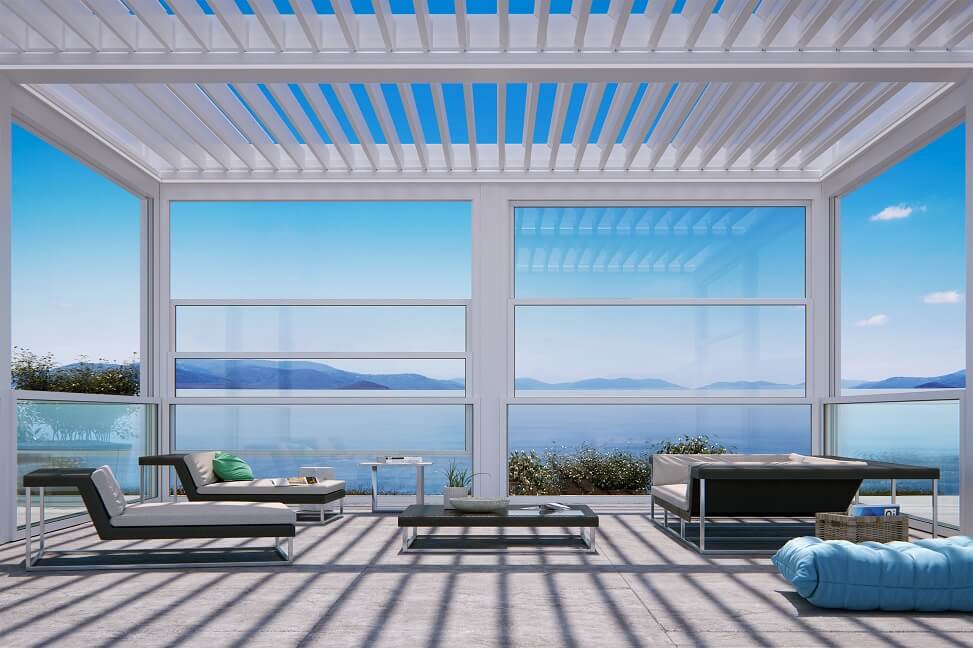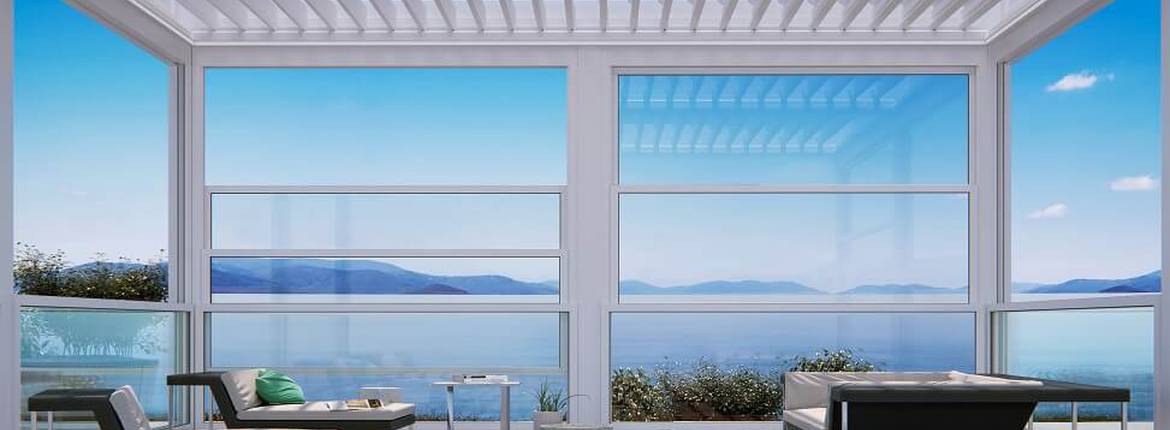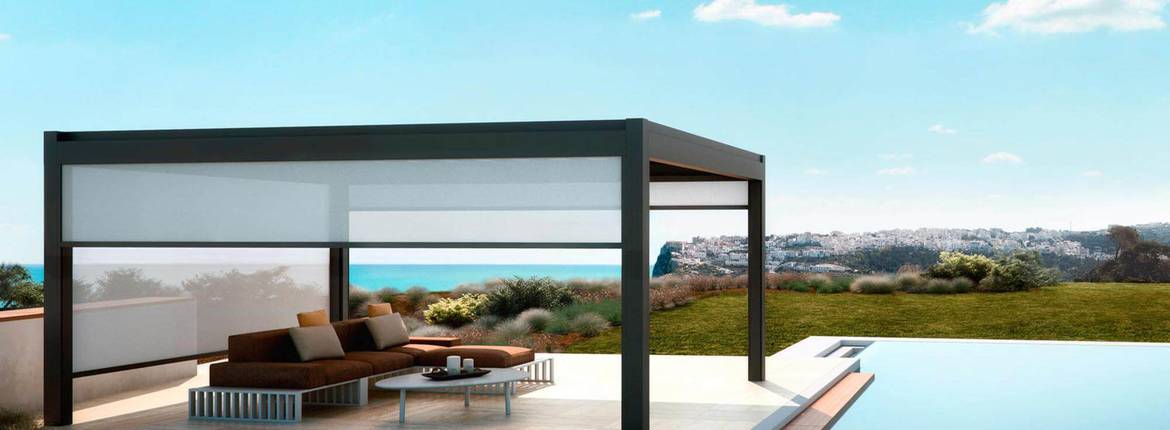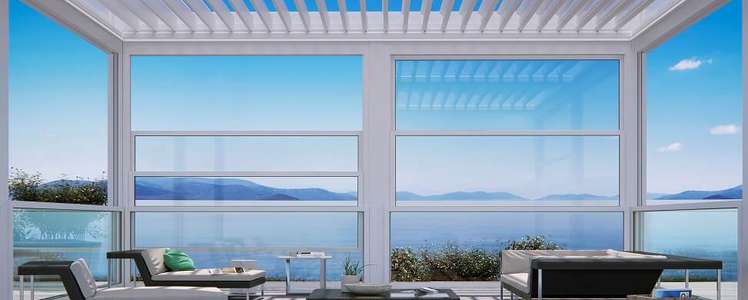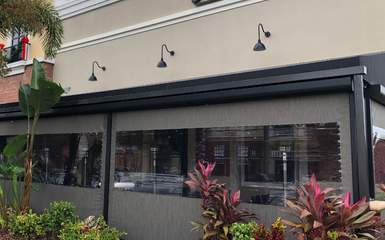Mobile home awnings don’t just offer extra outdoor space. They’re also smart additions to mobile homes as they make indoors more comfortable, especially if you live somewhere that experiences extreme weather conditions.
Shade your car from too much heat, or keep the snow off of it, so there’s no need to scrape ice while freezing. But these are just some of the benefits of getting mobile home awnings.
If you’re thinking of installing one for the first time or replacing the one you currently have, our ultimate guide should help you select the best mobile home awning.
We’ll also show pictures of mobile home awnings to give you an idea and some inspiration for your own mobile home.
Mobile home awnings we recommend for RVs and trailers
Here at RetractableAwnings.com, we offer different types of commercial and residential awning products. But here are the top 3 awnings that would suit any mobile home, trailer, or RV.
Folding Lateral Arm awnings

(Check out how our Venezia awning gave this bus an amazing upgrade)
If you want to go for a classic design that’s timeless and popular with homeowners, as well as building and establishment owners, folding lateral arm patio & deck awnings are the way to go.
Commercial retractable awnings can be easily folded or stowed away and can be conveniently stored until the next time you need them. They’re perfect for decks and patios as they can be retracted or extended to allow sunlight and the sun’s warmth during the winter season thus reducing your heating bill, protect patrons from light rain, and provide shade from damaging UV rays.
These awnings can be manually operated. But if you want to embrace the convenience and smart home effect, motorized ones that are controlled via sun/rain/wind sensors, motion sensors, voice control, tablet, mobile phone, timers, remote control, or with a wall switch will do the trick.
Side arm awnings

(These retractable side arm awnings looks great on the balcony of hotels and apartments)
Also known as drop arm awnings, side arm awnings are suitable for protecting smaller areas and come with many alternatives for customization. It’s simply a visually appealing upgrade to any door or window that needs a durable shade cover.
When we say custom awnings, we mean:
-
Width size can be as little as ⅛ of an inch (.32 cm)
-
Choose from various standard drop arm/side arm projections
-
Pick the valance style from these six designs
-
Hundreds of stripes, tweeds, and solid hue options to choose your solution-dyed acrylic fabric color from
-
Opt for a manually operated awning with a detachable crank or a motorized one with optional backup manual override (bmo) for easier and more convenient use
Canopy awnings

Complete your RV, house or your store’s character by adding canopy awnings that will improve the temperature indoors and outdoors while making it look stylish.
You can use a retractable canopy awning on mobile home windows, doors, as well as porches. It would also look great if placed over the doorway of a cafe or the serving window of a food truck.
If you need a big canopy awning to host events, just let us know how many guests should be accommodated under the canopy, and we’ll find the right one for the right occasion. You can also set up a patio canopy or gazebo canopy for people to lounge in while enjoying snacks and drinks.
The basic types of mobile home awnings
People invest in a mobile home for all sorts of reasons. Some realize that “less is more,” so they get a trailer or RV to serve as their tiny home, while others still want to travel while coping with the new normal. And there are those who use it for their business.
That is why we want to discuss all the options and everything there is to know about mobile home awnings.
We want to make sure that we get to cater to anyone interested in adding awnings to their mobile home.
Stationary awnings

Canopies are the best example of fixed awnings. They’re permanently installed on a home’s exterior and are quite stable. When purchasing any product, you want to weigh the pros and cons, so for this type, you should know that they tend to collect rainwater and snow easily.
When it comes to being sturdy, there’s a limitation to everything. For stationary awnings they won’t be able to withstand extreme weather conditions, such as strong gusts of wind and snow load.
Hiring a skilled professional to install this type of mobile home awning is best to ensure that they’re pitched enough, which will avoid snow and water collection. Make sure both rain water and snow do not collect on the fabric or frame.
Portable awnings

Those who prefer canopies that can be transported will consider this type convenient. And these Freestanding awnings can be moved from one spot to another.
Some portable awnings are even designed to follow the east-west trajectory so that you can keep relaxing as long as you want.
Slide on wire canopies

It’s no surprise that slide on wire canopies are quite popular. They can be folded when there’s a storm so that they won’t be ruined. Since they’re easy to use and adjust, mobile homeowners often request this simple type of shade cover.
Motorized awnings and pergola covers

(You can open and close your awning with a push of a button)
We mentioned motorized awnings earlier. This type can be rolled using an electric mechanism along with a remote control or wall switch if you don’t want to go outside to deal with it. Stay dry and comfy while extending or retracting your awning.
Materials: What are mobile home awnings made of?
The most common material used for manufacturing awnings is canvas because it’s flexible, resilient, and inexpensive. It’s generally not what you want in a retractable mobile home awning as its elasticity is a downside as it eventually collects rainwater and snow. In addition, it adds weight to the awning, which may be dangerous. A much better fabric choice is solution dyed acrylic as it is breathable, adds less weight to the awning frame and since the yarn is solution dyed prior to weaving it will last at least 10 years.
Others are made of steel. We can’t deny that they’re a more durable alternative to fabric , but they can absorb too much heat when it should be reflecting it. Also, it’s pretty heavy, so only a skilled professional should install it for you.
Aluminum awnings are a lighter-weight metal thatmight be a better material for your mobile home cover. They can be made with insulated roof panels or W-pans, which usually last longer.
You can add clear strips between each aluminum panel to let a little natural light brighten up your patio or porch.
There are homeowners who select wooden frames because they’re also sturdy, then they add sliding wicker shades.
What to consider when choosing mobile home awnings
Before buying mobile home awnings, you need to take into account a few factors that will help you pick the right product. It should meet your needs and give you value for your money. Here are some questions you should ask yourself and a few tips…
1: Why do you need a mobile home awning?
We know why awnings are useful for any home, but it should be clear to you what you’re specifically using them for. Is it to add outdoor living space for your trailer? Do you want to protect your entertainment area and furniture from the sun,and/or rain, and/or snow?
There are many reasons you can come up with, and luckily, there’s a right awning for every task.
We mentioned weighing the pros & cons of the awning you’re eyeing on, so ensure that you evaluate the drawbacks, benefits, and countless ways you can use that certain awning.
2: What awning design is best for your mobile home?
Any visitor you have will initially see your home’s awning before they even get to unwind under it. Just like with the first question, consider asking yourself if that certain design can withstand any weather condition. Will it get damaged? How about the color of both the frame and fabric?
For example, if you live in a place that often gets heavy storms, choosing a fixed frame fabric awning might be a flimsy choice, even if you love its design. In that case a retractable frame fabric awning should be used since it can be closed prior to heavy wind, rain, bad storms.
3: Which material or fabric to go for?
We discussed materials used in making awnings, so this one’s a big deal. In the long run, the particular fabric you choose and its durability can implicate your budget, too.
Steel or aluminum cover awnings aren’t popular and get hot easily, so that it can be uncomfortable to lounge under them. Although they’re not popular, they’re solid and most can stand against storms and some snow.
Some fabric awnings will let more air in, making the spot they’re covering a comfortable area, but they’re not as firm.
Some fabrics used in awnings include:
-
Arylic
-
Solution dyed acrylic
-
Laminated vinyl
-
Plain vinyl
-
Hardened canvas
-
Cotton canvas
-
PVC coated polyester
4: Retractable, folding, or standard?
Standard fixed awnings are permanent until you replace them. Retractable mobile home awnings are more attractive, flexible, and can be adjusted anytime.
Still, what type of awning you choose will depend on the purpose you intend to use it for.
If you have fallen in love with folding arm retractable awnings, you also must choose between manual and motorized options.
5: What’s the cost of the awning?
Mobile homeowners always have a budget, and we only want to buy what we can afford. Besides the product, you also have to factor in the installation, maintenance (if not installing and maintaining yourself), and other expenses of getting a mobile home awning, especially with motorized awnings.
6: Where do you live?
Think about the weather conditions of where you live because different types of awnings have different levels of resilience under different climates.
There’s no point installing fixed/permanent metallic mobile home awnings if you live in a temperate or humid area. It wouldn’t also be a good idea to get fixed/permanent cotton-based awnings if your place always experiences snowstorms and violent winds. Retractable fabric awnings would be the best choice in this situation since they can be closed prior to a storm and thus avoid damage to the awning and the building to which it is attached.
Don’t miss:10 Things to Consider Before Buying a Retractable Awning or Retractable Pergola
Frequently Asked Questions (FAQs)
How much are mobile home awnings?
The average cost of an awning for a mobile home is around $8 per square foot. Not to mention the installation, as well as hiring an electrician (if needed) for motorized awnings. With RetractableAwnings.com, we have articles about Retractable Awnings Cost for our own products, as well as information about financing.
If you have any questions, you can contact our retractable residential and commercial awning, pergola, screen and canopy experts using our contact form, our live help chat or call us in the USA or Canada toll-free at (866) 438-2964 or outside the USA or Canada at (305) 628-2424.
Can awnings be attached to mobile homes?
Yes! In fact, they’re great additions to RVs and trailers, especially if you have a deck. They’re beneficial to mobile homes because they protect you from skin damage from getting too much sun while on your trip. It will control the temperature in and out of your mobile home, and it will add that curb appeal.
Many homeowners also attach awnings to their poolside fences, garages, and other stationary walls in their homes.
How do you install an awning on a mobile home?
Back in January 2009, we provided an installation of a folding lateral arm retractable awning on the DIY Network. We wanted to show how a homeowner with basic skills can easily install it. Check it out here.
Are retractable mobile home awnings worth it?
You’ll realize that they’re worth every penny once you experience the benefits they offer for your quality of life as a mobile homeowner. It helps you save on electric bills when the weather’s warm since it covers your window from letting direct sunlight in. Meaning you won’t have to keep the air conditioning blasting just to feel comfy.
When the season’s colder, just retract your awning to let the sunshine in, and you won’t have to turn on the heater thus saving $.
The verdict: Mobile home awnings are perfect for commercial and residential properties

Adding awnings will give your home an extra dimension and hide the obvious rectangular shape of a mobile home.
And if you’re planning to sell it, adding a few stylish retractable awnings will make your mobile home look more valuable and pleasing to the eye.
Whether you prefer motorized, retractable, folding, portable, or stationary awnings, we highly recommend considering all the different factors before deciding. You can also take a look at our Facebook and Instagram to help you imagine different ways to add our awnings to your home.
Do you have a favorite mobile home awning already? Share it with us in the comments section. If you already got awnings from us, let us know by leaving a message. If not, don’t hesitate to use our Awning Finder to browse our products.
Contact our European trained, experienced retractable residential and commercial awning, pergola, screen and canopy experts using our contact form, our live help chat or call us in the USA or Canada toll-free at (866) 438-2964 or outside the USA or Canada at (305) 628-2424. Our experts will assist you throughout the whole process!
![Folding Arm Awnings Folding Canopies]()
![Retractable Pergola Covers Awnings]()
![Retractable Drop Arm Awnings]()
![Retractable Patio Screens and Vertical Drop Awnings]()
![Retractable Window Awnings]()
![Retractable Free Standing Awnings and Canopies]()
![Retractable Lateral Arm Awnings]()
![Retractable Pergola Roof Covers]()
![Retractable Side Arm | Drop Arm Awnings]()
![Power Retractable Screens]()
![Retractable Canopies for Commercial Buildings]()




